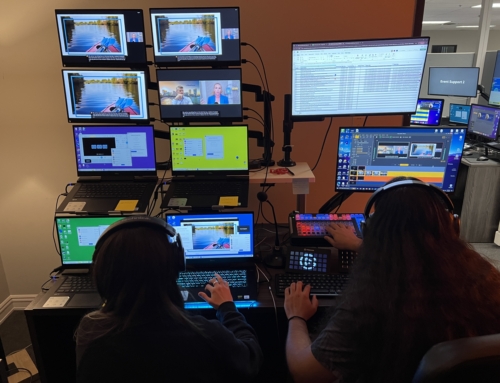Whether you are an event planner, an executive business leader, or a presenter, you want to know if your events produce a return on investment (ROI) regardless of the type of event. It is important to know if the event was successful and if it was worth the output of energy, time, and/or money. In assessing ROI, virtual events have a slight advantage over in-person events because there are so many different measures available that are unique to the digital domain.
The first step to measuring ROI is setting event objectives that align with business goals. These objectives will determine the metrics you will want to pursue. Common themes are attendee engagement, brand perception, customer satisfaction, products sold, leads generated, skills mastered, etc.
Typical objectives and measurement tools:
Create Leads/Sales
- Tools: Requests for information, emails input, media downloads, orders placed.
Increase Brand Awareness
- Tools: Likes, shares, comments, and gained followers on social media, dedicated event website views, traffic on the company website
Heighten Attendee Engagement
- Tools: Q&A activity, poll participation, media downloads, post-event survey results, chat involvement
Teach New Process or Skill
- Tools: Poll success, quiz results, Q&A activity, chat content, post-event survey results, certifications completed
When creating event goals, it is best to keep them as specific and measurable as possible. For example, create at least 50 new leads with a minimum of $50,000 revenue potential, or, get 80% correct responses on quizzes for 75% of attendees.
Once you have objectives and measurement tools, you must ensure your virtual event is engaging attendees with immersive experiences and activities that invite them to communicate, network, and interact.
Event activities ideas to engage virtual attendees:
- Live chat
- Live polls or quizzes
- Q&A
- Gamification with competitive individual or group activities
- One-on-One and group networking
To measure against your goals, you must review engagement data and observe your attendees’ reactions and interactions during the event.
Here are some metrics you can track in the virtual environment to get detailed data on attendees’ engagement with your event:
- How long attendees stayed logged into your event platform during the event?
- Proposed/accepted meetings between sponsors and attendees
- Proposed/accepted meetings between attendees
- Social shares of event content
- Number of questions during live Q&A
- Live poll participation
- Replay views
- Session attendance – Which sessions had the highest attendance?
- Session duration – How long did attendees stay to watch presentations?
With data in hand, you can then compare it to your objectives and see if you met or exceeded your goals. Celebrate and move forward if you did! If you didn’t, assess where things could have been better and begin making plans for your next event with some adjustments.
Easy access to detailed analytics is a big benefit to hosting virtual events. To make the most of it, next time you plan a virtual event, think of these steps:
Define Objective – Assess ROI – Celebrate – Improve
Schedule your demo today.






